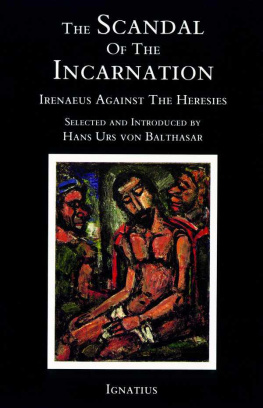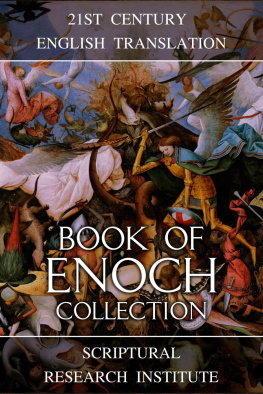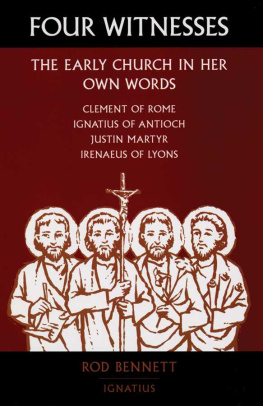The Scandal of the Incarnation
The Scandal of the Incarnation:
Irenaeus Against the Heresies
Selected and with an introduction by
Hans Urs von Balthasar
Translated by John Saward
IGNATIUS PRESS SAN FRANCISCO
Title of the German original
Irenus: Gott im Fleisch und Blut
Ausgewhit und Ubertragen von Hans Urs von Balthasar
1981, Johannes Verlag, Einsiedeln
Cover design by Roxanne Mei Lum
Cover art: Christ Mocked by Soldiers
Georges Roualt (1932)
Oil on canvas, 367 1/4 X 287 1/2 (92.1 X 72.4 cm.)
Collection, The Museum of Modern Art, New York
(Given anonymously)
Photograph 1990 The Museum of Modem Art, New York
1990 John Saward
All rights reserved
ISBN 978-0-89870-315-3
Library of Congress catalogue number 90-82992
Printed in the United States of America
CONTENTS
The God of revelation
The world is not the work of intermediaries
The creation is not a fall into the void
Intermediaries are an insult to God
Only the one true God can be creator of the world
The world is in God
The knowledge of God as faith in God
The arrogance of Gnosticism
The collapse of Gnosticism
Humility and the knowledge of God
Gods incomprehensible grandeur known because of His love
Ultimately, God can be known only through God
Trinitarian revelation
Nature, prophecy, incarnation
The exchange between God and man
Creation in Christ
The mystery of the Virgin
The recapitulation of suffering
The meaning of history
The meaning of creatureliness
The meaning of sin
Patient maturing
Continuity and discontinuity in salvation history
The Church
The world at the service of believers
The Eucharist
Soul between body and spirit
The Gnostic doctrine of fulfilment
The possibility of resurrection
Eternal life is a grace
Freedom as grace
The eternal movement towards God
INTRODUCTION
I
So-called gnosis was an enormous temptation in the early Christian Church. By contrast, persecution, even the bloodiest, posed far less of a threat to the Churchs continuing purity and further development. Gnosticism had its roots in late antiquity, drew on oriental and Jewish sources, and multiplied into innumerable esoteric doctrines and sects. Then, like a vampire, the parasite took hold of the youthful bloom and vigour of Christianity. What made it so insidious was the fact that the Gnostics very often did not want to leave the Church. Instead, they claimed to be offering a superior and more authentic exposition of Holy Scripture, though, of course, this was only for the superior souls (the spiritual, the pneumatic); the common folk (the psychic) were left to get on with their crude practices. It is not hard to see how this kind of compartmentalizing of the Churchs members, indeed of mankind as a whole, inevitably encouraged not only an excited craving for higher initiation, but also an almost unbounded arrogance in those who had moved from mere faith to real, enlightened knowledge .
All manner of attractions for the religious sensation-seeker were on sale at this gaudy funfair. Always in the background was the fundamental dogma of Gnosticismthe belief that the lower, material sphere, the flesh, the world of the psychic, was contemptible, something to be vanquished, while the higher, spiritual world was all that was excellent, the only thing worth cultivating. Sometimes extreme licentiousness was permitted or recommended, for after all to the pure all things are pure; at other times, the rule would be a body-hating asceticism. What mattered most was the knowledge that ensured spiritual power: the timetable for all the souls journeys in the hereafter, the ground plan and genealogy of all the cosmic spheres, the key to the riddles of nature, the knowledge of all the powers holding sway between earth and heaven, and, last but not least, a true anatomy of the Godhead itself. In fear and trembling, the adept gazed into the abyss of eternity. He could see, emerging from the eternal silence of the void, from the groundless abyss of the absolute, a teeming mass of powers, Aeons and divine emanations Being male and female, these mated with each other, forming couples (syzygies), in order to produce new beings belonging to the divine world. One of these, just one among many, was the redeemer of the world, the Christ .
Tragic scenes are played out in this eerie twilight zone between the unfathomable groundlessness of the divine, on the one hand, and the earthly world (which is still a thing of the future), on the other. The projecting of tragedy into the realm of the divine shows that the fantastic Gnostic systems, though very different from each other, are myths in the proper sense of the word. They are, therefore, all in unambiguous opposition to the Christian view of the world. For the Christian, Gods creation, in its material and spiritual totality, is very good. But, for Gnosticism, the world always comes into existence as the result of a tragic accident, a disaster, a fall. In the first book of his work Against the Heresies, Irenaeus tries to outline the diversity of these Gnostic myths. It will suffice here to list a few of their main themes .
For example, one of the gods, forgetting his origins, sets himself up as creator of the world (demiurgos). By his own power, and against the will of the Forefather (propator), he produces the earthly world, the realm of iron fate, of harsh justice, of bodiliness, of blind instinct. But, by cunning, an emissary of the supreme god penetrates the sphere of this antidivine Demiurge and goes down to earth. There, through initiation into the mysteries of the upper world, he redeems the elect (and only the elect! ).
In a second tragic myth, one of the Aeons that make up the divine Pleroma, namely, the daughter of God, Sophia (Achamoth), strays from the Pleroma; the material world arises out of her fears and tears, her secretions. The Christ, who once again is seen as coining down from the world of sublimity to penetrate the world of poverty, eventually redeems her together with the higher spiritual souls .
It was Marcion who taught the most dangerous form of this mythical struggle of the gods, the most dangerous because it is the one that seems closest to Christianity and least burdened by fantasy. What is more, he is keen on scriptural exegesis. Marcion identifies the evil Demiurge with Yahweh, the Old Testament God of justice. The redeemer who sets us free from his tyranny is Jesus the Christ. According to Marcion, the teaching of Jesus has unfortunately been mixed up by the evangelists with elements from the Old Testament, from which it must be set free. The principle of justice and the principle of love are in stark opposition, as are the religion of works and the religion of grace, the religion of legal exteriority and spiritual inferiority. This is the first systematic form of theological anti-Semitism .
The same conflict, the same dualism, runs through all the other systems of Gnosticism. In the earthly world it is reflected in the stark opposition of body and spirit. The bodily is regarded as something antidivine, which the spiritual person leaves behind and beneath him if he is to be redeemed and returned, through secret knowledge, to the supermundane regions of pure spirit from which he fell. The inferior, animal souls are incapable of such an existence. Catholics are occasionally conceded an intermediate existence between the two spheres, but at the end of the world, they do not reach the highest of the heavenly spheres, but only the cosmic centre. From this very general description, we can see that Gnosticism is radically anti-Christian. Irenaeus, with great perspicacity, understood this, and showed it up for what it was. For him, Christianity is about the divine and spiritual Word becoming flesh and body. The redemption depends on the real Incarnation, the real suffering on the Cross, and the real resurrection of the flesh. All three of these are a scandal for Gnosticism. On their view, Mary is not really Mother of God, and Christ did not really sufferno, the heavenly Christ made off before the man Jesus suffered, and there can be no question at all of an actual resurrection of the flesh. Underlying this refusal of the flesh and Us saving role in the Incarnation is a confusion between the human spirit (nous) and the divine Holy Spirit (Pneuma Hagion). The former puts itself in the place of the latter and identifies itself with it. And so the main object of Irenaeus anti-Gnostic polemic is the salvific character of the Incarnation of Gods Son and Word. Similarly, writing against Marcion, he proves the indispensability of the fleshly Old Testament for the spiritual New Testament by showing the old covenant to be basically an adaptation of the divine Word to live in fleshly man, or, expressing the same idea from the other side, as the adaptation of earthly man to be the bearer of the divine Word . Caro cardo salutis, the flesh is the hinge, the decisive criterion, of salvation: this well-known saying of Tertullian, upon whom Irenaeus had a lasting influence, can in fact be regarded as the very centre of Irenaeus theology .
Next page






